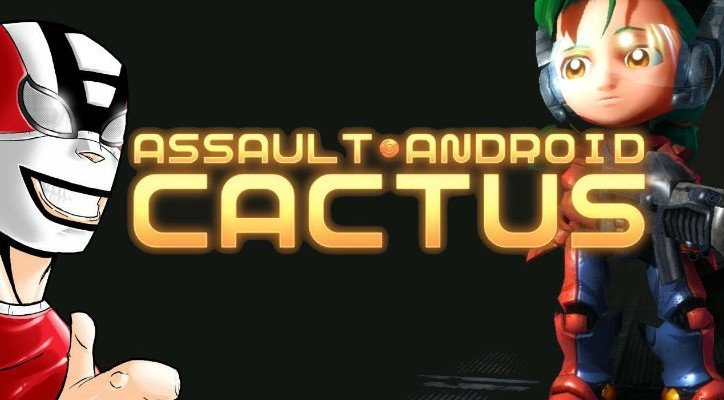For such a simple game concept, multi-directional shooters boast an impressive pedigree that goes back years (and decades) to the likes of Spacewar!, Asteroids, Smash TV, Geometry Wars, and I MAED A GAM3 W1TH Z0MBIES 1N IT!!!1. The bar is actually set pretty high for Assault Android: Cactus to get noticed amongst its frenetically-paced, flashy, and easily-accessible forebears.
If you’ve played any of the above titles, you know the drill here. Enemies close in on all sides, and you can blast ridiculously powerful weaponry in all directions to destroy them. Assault Android: Cactus actually has, I think, more depth to it than the average shmup. Hitting the spacebar switches to a much more powerful secondary weapon, but usage is limited, and it needs a few seconds to recharge. There are five different playable characters, each with different primary and secondary weapons. The titular Cactus wields a standard machine gun and a close-range flamethrower, while my personal favorite character, Coral (but not the one I have the most success with), clobbers away with a short-ranged spread shotgun and large area-of-effect, sustained-damage mine. Another character shoots weak-powered homing bullets, but her secondary weapon is a cannonball that rolls over enemies in a straight line. The delightful effect is to create an opening to charge after this path of destruction and escape a tight spot.
The action might get old with just one character, but switching between the five playable options noticeably freshens up the nature of the combat, especially with the added twists from level design. Some of the levels are simple circular arenas, while others lend themselves to figure-eighting around the enemies or taking cover behind obstacles when they pour out bullets. Some of the levels are fluid in structure, and enemies were crawling out from seemingly random spawn points. I had a hard time getting my head around that one, but the action was too fast for me to be able to dwell on it much.
The defining, unique curveball to this game is the characters’ batteries. Instead of having a limited number of lives, you can actually “die” (you get knocked out and must waste precious time reviving yourself) as many times as you need to. However, your battery is constantly ticking down to Game Over depletion. Enemies drop green orbs that recharge the battery, but you’re constantly on the clock, and I’m having a hard time deciding whether or not I like this mechanic. You really don’t get very long at all before you need to recharge, and in most cases, the game seems to wait until you’re pretty desperate before giving it to you. If there’s a way to get more enemies to drop recharges or to find the one on the screen that’s carrying it, I haven’t figure that out yet. The biggest frustration that I experience with this game is running out of battery power inches away from grabbing the recharge, especially after I skillfully avoided going down for the count even once. Grumble.
I have to give props to boss fights here. Each boss fight is a level unto itself and are reminiscent of bullet-hell battles in games like 1942 or Contra. Here was where I noticed the game wouldn’t toss you the recharge just as you need it; you have to earn that sucker by piling up damage on the boss. Do it efficiently, and you’ve got plenty of battery life to work with – whiff a lot, and you’ll keel over before the recharge ever appears.
This game is eye-catchingly pretty, even on the medium graphics settings I had to scale to just for my under-powered machine to run it smoothly. I’m a little sheepish to admit that I don’t know exactly how it looks with all the dials turned up to 11 because my computer just wasn’t having it. Graphics pull more weight in this sort of game than many others, so I’m pleased to report that Assault Android: Cactus fills the screen with seizure-inducing lights, colors, and explosions. Characters and enemies move smoothly (or jerkingly, depending on the type of robot) and pop vividly.
A word about multiplayer: this game will have up to four players, but my preview version didn’t include any capability to connect with others. I’m not sure if multiplayer will somehow scale battery life to accommodate the recharge needs of four people or what, but I can assume the sheer volume of flashing, explodey stuff will reach WTF levels.
I can’t see how this game could fail to get green-lit; it seems like a shoo-in. I think the only thing that can prevent it from being a hit would be having too high of a price point. A word to developer Witch Beam: I’d like to see this game hit consoles as well. Somehow, I have a more natural time playing multi-directional shooters with thumbsticks than a mouse and keyboard.





